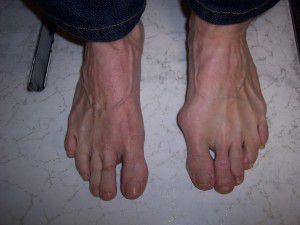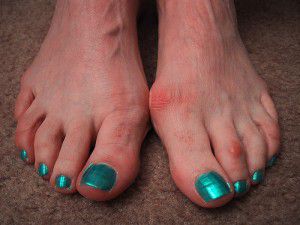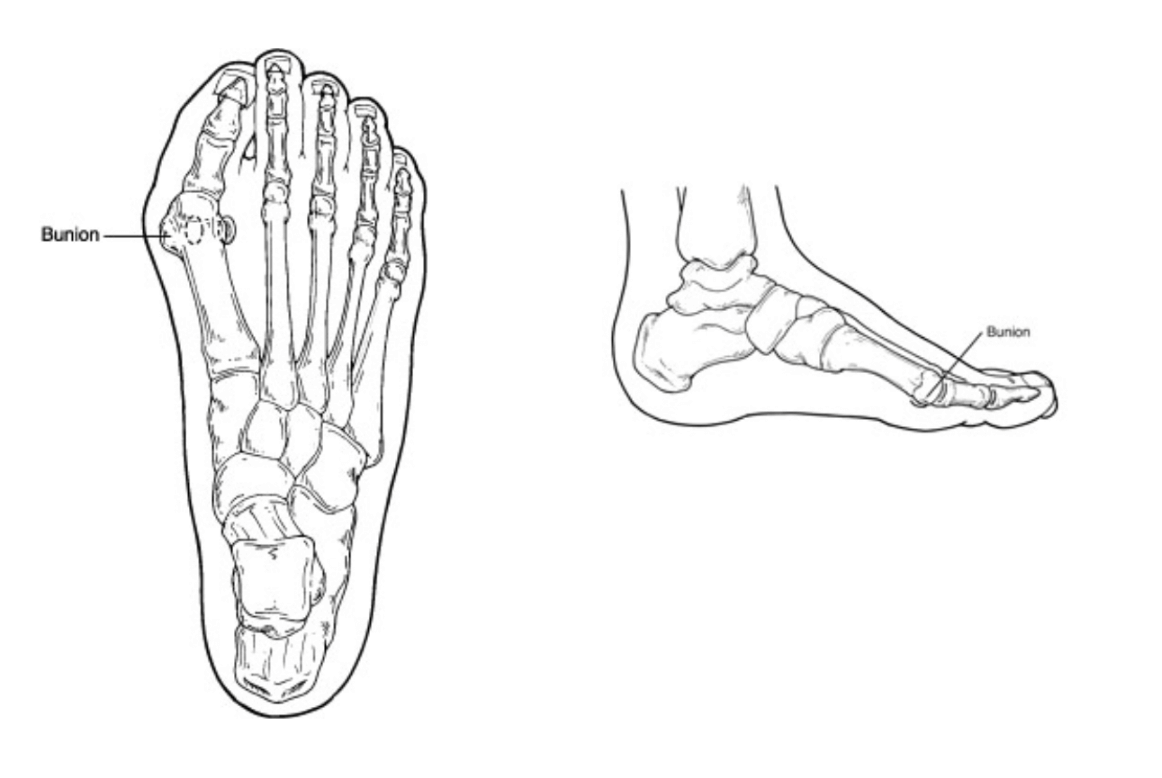What is a Tailor’s Bunion?
A tailor’s bunion is a bunion that occurs on the little toe where the metatarsal bone meets the little toe. It is also referred to as a bunionette.
Causes and Symptoms
Tailor’s bunion is a deformity caused when the head of the metatarsal is pushed outwards. The result is often a painful and swollen protrusion from the side of the foot. Bunions are a progressive disorder and as a result any pain and discomfort will likely become worse over time. They begin with a leaning of the big toe, gradually changing the angle of the bones over the years and slowly producing the characteristic bump, which becomes increasingly prominent. With tailor’s bunions there is a potential for lesions to occur from abrasion, typically from footwear causing irritation.
Symptoms usually appear at later stages, although some people may never have symptoms. Bunions are a common foot deformity that can be inherited or occur as a result of repeated stress to the joint. It is not the bunion itself that is inherited, but certain foot types that make a person prone to developing a bunion. Not wearing proper sized footwear that crowd one’s toes will not cause bunions, however it can contribute to the progression of the deformity. As a result, symptoms may appear sooner with improper footwear. The constant pressure and rubbing that footwear can produce will irritate a tailor’s bunion and contribute to the progression of the disorder.
Symptoms, which occur at the site of the bunion, may include:
- Pain or soreness
- Inflammation and redness
- A burning sensation
Symptoms occur most often when wearing shoes that crowd the toes, such as shoes with a tight toe box or high heels. This may explain why women are more likely to have symptoms than men. In addition, spending long periods of time on your feet can aggravate the symptoms of bunions.
Diagnosis
Bunions are readily apparent and the prominence is visible. However, to fully evaluate the condition, the foot and ankle surgeon may take x-rays to determine the degree of the deformity and assess the changes that have occurred. Because bunions are progressive, they don’t go away, and will usually get worse over time. But not all cases are alike – some bunions progress more rapidly than others. Once your bunion has been evaluated, a treatment plan can be developed to suit your needs.
Non-Surgical Treatment
Most people however, find relief from wearing soft, pliable shoes, and arch supports, and from applying ice to the sore toe joint Sometimes observation of the bunion is all that’s needed. To reduce the chance of damage to the joint, periodic evaluation and x-rays by your surgeon are advised.
In many other cases, however, some type of treatment is needed. Early treatments are aimed at easing the pain of bunions, but they won’t reverse the deformity itself. These include:
- Changes in footwear. Wearing the right kind of shoes that provide enough room for your foot is important. Choose shoes that have a wide toe box and avoid those with pointed toes or high heels which cause the toes to crowd and may aggravate the condition.
- Padding. Pads or moleskin placed over the area of the bunion can minimize pain. These can be obtained from your surgeon or purchased at a drug store.
- Activity modifications. Avoid activity that causes bunion pain, including standing for long periods of time.
- Medications. Oral nonsteroidal anti-inflammatory drugs (NSAIDs), such as ibuprofen or aspirin, may be recommended to reduce pain and inflammation. Talk to your doctor about which pain reliever is best for you.
- Icing. Applying an ice pack several times a day helps reduce inflammation and pain. During periods of rest/icing, try to elevate your leg.
- Injection therapy. Injections of corticosteroids may be useful in treating the inflamed bursa (fluid-filled sac located around a joint) sometimes seen with bunions.
- Orthotic devices. In some cases, custom orthotic devices may be provided by the foot and ankle surgeon.
When Is Surgery Needed?
Severe bunions may need to be surgically corrected. A variety of surgical procedures is available to treat bunions. Surgical procedures are designed to remove the “bump” of bone, correct the changes in the bony structure of the foot, and correct soft tissue changes that may also have occurred. The goal of surgery is to reconstruct the foot and therefore reducing pain.
Bunions and Tailor's Bunions are one of the most common conditions that we treat.
Because we treat so many patients with bunions we have developed a division of Issaquah Foot and Ankle Specialists that is dedicated to effective bunion treatments.
Visit the Washington Bunion Center website today to learn more about bunions, Tailor's bunions and our effective treatments.







 Are you experiencing pain related to a bunion?
Are you experiencing pain related to a bunion? he Bellevue foot surgery Center gets quite a few questions about minimally invasive bunionectomies. Minimally invasive bunionectomies refer to a very small incision to decrease the appearance of scarring and some doctors report quicker recovery times. The Bellevue Foot Surgery Center has performed thousand surgical procedures and from experience we continued there is no quick fix or minimally invasive technique for the majority of bunions. The most important thing when contemplating bunion surgery is proper procedure selection and this dictates the size of your incision. Very small bunions we can perform a minimally invasive incision however by the time most people like to have surgery for bunionectomy there bunions are fairly large. However, the fact that we perform so many bunionectomies we normally can keep our incisions fairly small and have advanced protocols to increase recovery injury to back to your preoperative activities. We have taken years to perfect our protocols and will guide with the postoperative course including physical therapy, nutritional supplements, bone healing and other advanced techniques or outcome. If you have a bunion or contemplating surgery and live in Seattle, Bellevue, Issaquah, Kirkland, Maple Valley please call the Bellevue Foot Surgery Center a division of Issaquah Foot & Ankle Specialists at 425-391-8666.
he Bellevue foot surgery Center gets quite a few questions about minimally invasive bunionectomies. Minimally invasive bunionectomies refer to a very small incision to decrease the appearance of scarring and some doctors report quicker recovery times. The Bellevue Foot Surgery Center has performed thousand surgical procedures and from experience we continued there is no quick fix or minimally invasive technique for the majority of bunions. The most important thing when contemplating bunion surgery is proper procedure selection and this dictates the size of your incision. Very small bunions we can perform a minimally invasive incision however by the time most people like to have surgery for bunionectomy there bunions are fairly large. However, the fact that we perform so many bunionectomies we normally can keep our incisions fairly small and have advanced protocols to increase recovery injury to back to your preoperative activities. We have taken years to perfect our protocols and will guide with the postoperative course including physical therapy, nutritional supplements, bone healing and other advanced techniques or outcome. If you have a bunion or contemplating surgery and live in Seattle, Bellevue, Issaquah, Kirkland, Maple Valley please call the Bellevue Foot Surgery Center a division of Issaquah Foot & Ankle Specialists at 425-391-8666.
